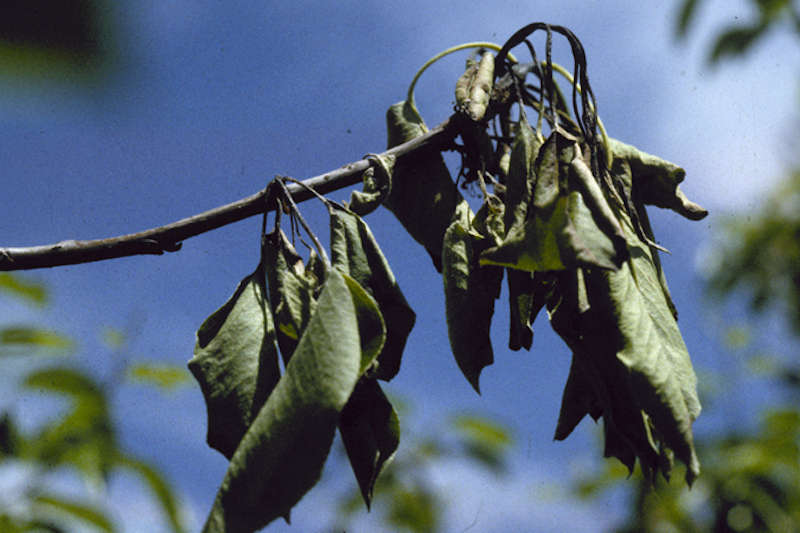Easy-to-care-for shrubs are a pleasure to grow in the garden. Few are as ornamental and low maintenance as spirea. Spireas are bothered by few pests and even fewer diseases in most hardiness zones, although powdery mildew (Microsphaera pencillata) and fire blight (Erwinia amylovora) can be a problem almost anywhere spirea grows. Both diseases can be found in garden soil and spread easily between plants by wind and/or rain.
Spirea Powdery Mildew
Powdery mildew is one of the easiest fungal diseases to diagnose. It affects a wide range of ornamental and edible plants, usually infecting the newest growth first and then moving to the stems and older foliage. Spores can move from plant to plant on the wind and by overhead watering. Low humidity and cool nights favor the spread of powdery mildew. Spireas grown in too much shade or in densely planted garden beds are the most susceptible to outbreaks.
Identifying Powdery Mildew
White, creamy, or silvery powdery-looking spots appear on the youngest growth of the spirea. The spores grow superficially on the plant and quickly expand into large masses. Affected flower buds and foliage may appear distorted or stunted, and may fall off the shrub prematurely.
Treating Powdery Mildew
Plant spirea in a location with at least partial sun and plenty of space between shrubs to allow for good air circulation. Avoid overfertilizing, which often encourages plants to produce weak growth that is highly susceptible to disease attack. Remove affected branches and foliage as quickly as possible after diagnosing powdery mildew.
Copper-based fungicides specifically listed for use on spirea are effective in protecting undamaged parts of a shrub. Repeated applications will be necessary after heavy rainfall for full protection. Overhead watering with sprinklers should be confined to late morning when temperatures have warmed for the day and plants have time to dry fully before nightfall. Choose spirea cultivars that are listed as disease resistant.
Spirea Fire Blight
Fire blight is a bacterial infection that strikes all species in the rose family. Spirea is highly susceptible to fire blight when pruned at the wrong time of the year or when grown near infected plants in the rose family. The bacteria are easily spread through soil and infected plant material, and during rain storms when there are active cankers on the plants. The first part of the shrub to show damage is the flower buds, either open or still developing.
Identifying Fire Blight
All parts of the shrub, usually starting with unopened flower buds, will turn brown or black and look like they were burned in a fire. The affected plant material is not usually dry or crispy but remains pliable. The bacteria cause cankers on woody stems, which eventually exude a bacteria-filled ooze if the infection is left untreated. Any plant material that remains on the plant or on the soil over winter will infect the next season's growth.

Photo by Oregon State University, unmodified, Flickr, Copyright CC BY-SA 2.0 DEED
Treating Fire Blight
Choosing plants resistant to fire blight is the best way to keep this infection out of your garden. For affected plants, remove as much of the infected plant material as possible. The best time to prune is when the plants are dormant in late winter because the sap is not likely to ooze from cuts and the branches are dry. Pruning during active growth can be done during dry weather; make cuts at least 12 inches below the affected plant material to remove as much bacteria as possible. Removal of the whole plant may be necessary and will protect other plants better than spraying chemical treatments. Deadheading spent flowers and removing leaves at the end of summer will help to reduce the amount of bacteria overwintering in the garden bed.
Joe Pye Weed Disease Chart
| Disease | Identifying | Treating |
|---|---|---|
| Powdery Mildew | White, powdery-looking spots on the tops of leaves | Remove affected foliage and stems; fungicide spray to protect unaffected growth |
| Fire Blight | Part or all of the shrub turns brown or black and has a scorched appearance | Good garden hygiene, sterilizing pruning tools, remove as much of the affected plant material as possible |
Sources: "Spirea (Spirea)." Connecticut State - The Connecticut Agricultural Experiment Station. portal.ct.gov
 |
Author Robbin Small - Published 1-4-2024 |
